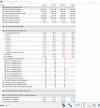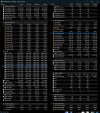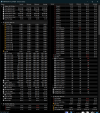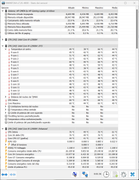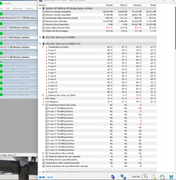I've got the 6B8B2EA with the RTX A1000 and 32GB of memory for 1500 Euro's without tax. HWInfo screenshot below just after running a series of tests with Intel Dynamic Tuning disabled.
There is just one PCIe 4.0 NVME slot though. Just did a test with a (low cost) USB 3.2 NVME enclosure that has PCIe 3.0 like performance in reading and writing, and when using it as temp space on windows it has eliminated almost all IO waits on the 20 threads and improved compilation time with "just" another 4%. I guess a single PCIe 4.0 NVME slot/disk is probably an OK compromise for this system. On Linux with memory based tmp file system, I am not expecting many IO waits during compilation.
When the system boots with Intel Dynamic Tuning disabled, the PL1 power limit is set to 25W and PL2 to 107W (as before). Started Intel XTU, which told me I have to disable Windows CPU core isolation first (seemed to be turned on by default). Once disabled, I could set the PL1 back to 75W. When redoing my tests while running throttlestop, I now notice that the performance cores were running at 3.4GHz and my kernel compilation was 20% faster and so were the TS Bench tests. For tests that only use 4 to 6 cores, I see the preformance cores go into turbo boost mode. Interestingly HWInfo shows 4.690GHz (4.7GHz as per the CPU spec), but throttlestop only shows an FID of 44.16. Not sure what that exactly means, but I am not an expert in these tools at all... TS Bench 960M I get to around 56 seconds, 92C and 68W CPU package for 20 threads.
Interestingly with one of the benchmarks all performance cores were around 3,4GHz resulting in a similar 20% performance gain, I managed to reach a core max of 100C according to HWInfo on 4 CPU cores for just a tiny fraction (resulting in a thermal throttle according to HWInfo), but coretemp and throttlestop did report "only" a max of 97C on just 3 cores and no thermal throttling... Anyhow, no way to get the CPU package above 72W.
For the work I do the system is absolutely great. Clean compilation of a large project is done before I can have a good look at what is going on in HWinfo... The 20 threads do make a real difference.
While it is possible to get all the performance cores in max turbo boost without throttling, it is not possible to do this with all 20 cores at 100CPU. 3.4GHz seems to be the max then.
Wil do some more tests with Intel Dynamic Tuning enabled, now that I have disabled the Windows CPU core isolation which seems to make a difference according to
this article.
